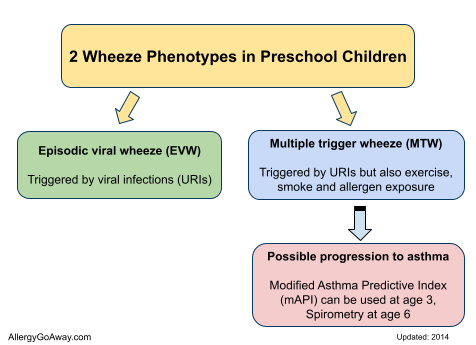Perinatal risk factors for persistent wheezing in first 8 years of life: male gender, parental allergy, not breastfeed
This study from the Netherlands used a data-driven approach to identify 5 wheezing phenotypes among almost 4,000 preschool children aged 0-8 years, in the Prevention and Incidence of Asthma and Mite Allergy (PIAMA) birth cohort:
- never/infrequent wheeze
- transient early wheeze
- intermediate onset wheeze
- persistent wheeze
- late onset wheeze
Perinatal factors were collected at 3 months, and wheezing was assessed annually until the age of 8 years. Complete data were available for 2,728 children.
Risk factors for transient early wheeze (n = 455) were male gender, maternal and paternal allergy, low maternal age, high maternal body mass index, short pregnancy duration, smoking during pregnancy, presence of older siblings and day-care attendance.
Risk factors for persistent wheeze (n = 83) were male gender, maternal and paternal allergy, and not receiving breastfeeding for at least 12 weeks.
This study identified risk factors for specific childhood wheezing phenotypes.
It is very important that some them are potentially modifiable, for example, maternal age and body mass index, smoking, day-care attendance and breastfeeding. The modifiable risk factors can be targeted by prevention programs.
Wheeze Phenotypes in Preschool Children (click to enlarge the image):

References:
Perinatal risk factors for wheezing phenotypes in the first 8 years of life.
Caudri D, Savenije OE, Smit HA, Postma DS, Koppelman GH, Wijga AH, Kerkhof M, Gehring U, Hoekstra MO, Brunekreef B, de Jongste JC. Clin Exp Allergy. 2013 Dec;43(12):1395-405. doi: 10.1111/cea.12173.
http://www.ncbi.nlm.nih.gov/pubmed/24261948
- never/infrequent wheeze
- transient early wheeze
- intermediate onset wheeze
- persistent wheeze
- late onset wheeze
Perinatal factors were collected at 3 months, and wheezing was assessed annually until the age of 8 years. Complete data were available for 2,728 children.
Risk factors for transient early wheeze (n = 455) were male gender, maternal and paternal allergy, low maternal age, high maternal body mass index, short pregnancy duration, smoking during pregnancy, presence of older siblings and day-care attendance.
Risk factors for persistent wheeze (n = 83) were male gender, maternal and paternal allergy, and not receiving breastfeeding for at least 12 weeks.
This study identified risk factors for specific childhood wheezing phenotypes.
It is very important that some them are potentially modifiable, for example, maternal age and body mass index, smoking, day-care attendance and breastfeeding. The modifiable risk factors can be targeted by prevention programs.
Wheeze Phenotypes in Preschool Children (click to enlarge the image):
References:
Perinatal risk factors for wheezing phenotypes in the first 8 years of life.
Caudri D, Savenije OE, Smit HA, Postma DS, Koppelman GH, Wijga AH, Kerkhof M, Gehring U, Hoekstra MO, Brunekreef B, de Jongste JC. Clin Exp Allergy. 2013 Dec;43(12):1395-405. doi: 10.1111/cea.12173.
http://www.ncbi.nlm.nih.gov/pubmed/24261948